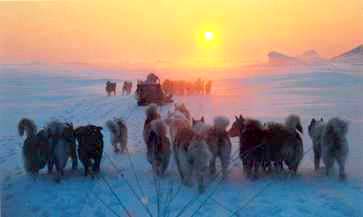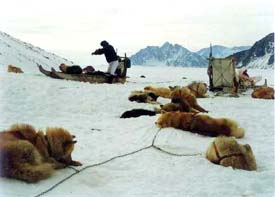Table of Contents
*
The Return
*
Dogs in Greenland
*
The Contribution of Dogs to Exploration in Antarctica
*
Page from the Behaviour Notebook: Raising Raven
*
Antarctic Sketches
*
Physiology of Sledge Dogs
*
The Qitdlarssuaq Chronicles, Part 2
*
News Briefs:
Thesis update
Blue Eye update
Mailbag
*
Product Review: DirectStop®
*
Book Review: Carved from the Land
*
Tip for the Trail: Re-lining Water Jug Caps
*
IMHO: Preservation vs. Saving
Navigating This
Site
Index of articles by subject
Index
of back issues by volume number
Search The
Fan Hitch
Articles
to download and print
Ordering
Ken MacRury's Thesis
Our
comprehensive list of resources
Talk
to The
Fan Hitch
The Fan
Hitch home page
ISDI
home page
Editor: Sue Hamilton
Webmaster: Mark Hamilton
Contents of The Fan Hitch Website and its publications are protected by international copyright laws. No photo, drawing or text may be reproduced in any form without written consent. Webmasters please note: written consent is necessary before linking this site to yours! Please forward requests to Sue Hamilton, 55 Town Line Rd., Harwinton, Connecticut 06791, USA or mail@thefanhitch.org

Teams in Greenland Ochovsky photo
Dogs in Greenland
by Lucien Ochovsky, Poprad, Slovak Republic
Greenlanders harness twelve or more Greenland Inuit Sled Dogs (GISD) to a sled. The selection of non-aggressive dogs ensures the cooperation of such a large number on a team. Each team is also extensively socialized so that they can travel together, and should it become entangled with another team a fight won't necessarily break out. The Greenlanders will chose to mate a bitch with a submissive dog, not the boss dog, in the hope that the more gentle qualities will be passed on.
The GISD has a strong pack and territory instinct. The hierarchy is fixed and fights are rare. The alpha dog and the alpha female keep order among the rest of the pack. Each dog knows its place in descending order. They pull in fan hitch and they are next to each other when they are fed. They wait for their turn.
Socialization starts at birth. The adult dogs are picketed two by two on one stake. The chain is four meters (13 ft) long and is attached with two swivel devices. Only pairs of dogs that get along together, usually a dominant and a submissive one, are staked together. Physical contact with neighboring dogs is not possible as two to five meters (6 ft to 17 ft) separates them. Each pack is tethered twenty to fifty meters (62 ft to 155 ft) from another pack. During a trip, dogs are picketed two-by-two on a stakeout chain or in a fan hitch. The end points of the lines are buried under the ice.
Bitches are provided with a wooden kennel. At first, puppies roam free. As they grow they are picketed. The bitch's male companion remains on the stake the whole time, including during the birthing. Never are two bitches picketed together. There are never more than two or three bitches in any one pack.
As they grow, the puppies explore the pack and come into contact with the other dogs. The adults generally avoid or ignore the juvenile dogs. They don't hurt them.
At about four months of age, the behavior of adult and young dogs begins to change. The juveniles start a process of integration into the pack. The adults begin to see challengers in the young dogs and try to subordinate them. The pups who do not submit are attacked, but can run out of the way since the adult is attached. Puppies are usually submissive but some are not. If they get caught by an adult they could be killed. Usually, pups respect the adults.
The pups know their territory and the members of their pack, which they distinguish them from other packs. Infringement on another pack's territory leads to a fight. Some pups get killed by the members of their own pack and sometimes by other packs. Only the healthy and submissive pups survive to take their place in the team.
The GISD is not aggressive toward other dogs and never toward people. If a dog becomes aggressive, he is euthanized. Usually, only one or two pups make it to adulthood. They die of disease, freeze or are killed by adults. This is natural selection at work.
The well-socialized adults accept submissive dogs from another pack. The young dogs are exchanged with others packs. Dogs of the same sex and same litter may cause trouble. The Canadian Inuit say they are "of one mind".
The juvenile dogs run free alongside the sled. From time to time, they join the dogs in harness and imitate the pulling motion.
At the age of ten months, they are put in harness on the outside of the fan hitch. At this age, they are not able to pull for the whole journey and are allowed to run with a loose rope. They are prevented from getting behind the sled - a piece of wood is tied to the middle of all the lines so that if the pups were to go toward the back of the sled they cannot reach it.
Weak dogs sometimes lie down, resigned, and are dragged by the rest of the team. Some hunters take the dog to the sled and strike his nose with the whip handle. Others simply allow the dog to rest on the sled, or to run free next to the sled for the last few kilometers.
After the first journey, the juvenile is staked out by himself for sometime before being picketed with an adult.
If an adult dog is introduced to a team, he has very little chance of survival. The pack rarely accepts a newcomer.
Such is a dog's life in Greenland.

Making camp in
Greenland
Ochovsky
photo